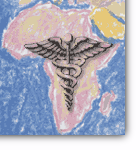

|
NASA Scientists Use Satellites to Help Track and Control a Disease July 15, 1999
Lynn Chandler RELEASE: 99-81 NASA SCIENTISTS USE SATELLITES TO HELP TRACK A DISEASE AND KEEP IT UNDER CONTROL Using weather satellites to spot the early signs of an El Nino, scientists may be able to help save East Africans and their livestock from Rift Valley Fever, a mosquito-borne disease that can be fatal to humans and animals. NASA and Department of Defense researchers have determined that rising sea-surface temperatures in the western equatorial Indian Ocean, combined with an El Nino in the Pacific, can lead to abnormally heavy rains in East Africa. These rains create a favorable habitat for the mosquitoes that carry the Rift Valley Fever virus, spreading it to humans and animals. Researchers at NASA's Goddard Space Flight Center, Greenbelt, MD, and the Department of Defense-Global Disease Infections System, Walter Reed Army Institute of Research, Washington, DC, studied nearly five decades of data to produce these findings. According to their report in the July 16 issue of the journal Science, satellite data can help predict Rift Valley Fever outbreaks up to six months in advance. "In the early 1980s, we discovered a cycle of Rift Valley Fever outbreaks that appeared to depend on rainfall," said Kenneth Linthicum, a Walter Reed entomologist. "There were large outbreaks every seven to ten years, but the virus apparently disappears between outbreaks," he said. Linthicum consulted with Assaf Anyamba, a Goddard geographer who uses satellites to study the effects of El Nino, a phenomenon that occurs when sea-surface temperatures rise in the eastern Pacific Ocean. They found that some El Nino episodes over the past five decades led to large Rift Valley Fever outbreaks. During an El Nino, East Africa often receives more rain than normal, but El Nino alone does not ensure an outbreak. According to Anyamba, the decisive factor is the warming of the Indian Ocean along with the Pacific, which occurred in two of five El Ninos over the last 17 years. "When the western equatorial Indian Ocean is similar to the East Pacific Ocean in xsea-surface temperature, there will likely be a large-scale outbreak of Rift Valley Fever following heavy rainfall over large areas of East Africa," he said. "What's interesting here is that satellite data can provide advance warning of conditions suitable for Rift Valley Fever outbreaks and then identify the actual areas affected," said Compton Tucker, a Goddard biologist who has used satellite data to study vegetation in Africa for over 20 years. Satellites provide synchronous measurements of ocean temperature and vegetation conditions. The close relationship between ocean temperature, rainfall and land vegetation helps scientists determine which areas received the most rain and are greener than normal, making them likely habitats for the mosquitoes that carry the Rift Valley Fever virus. The Rift Valley Fever virus is passed into the eggs of Aedes mosquitoes. The mosquitoes lay their eggs in moist soil when floodwaters recede. The young insects hatch when the area is re- flooded and feed on local livestock. A second kind of mosquito, the Culex, then causes the large outbreaks by contracting the virus from infected livestock and spreading it rapidly. Culex mosquitoes are only prevalent when there are excessive rains. Heavy rains typically hit the area over Eastern Africa only when both oceans are warmer than normal. The virus causes death in livestock populations and produces flu-like symptoms that can be fatal to humans. Linthicum suggests that insecticides placed into the soil months before the mosquito season will stop production of the Aedes mosquitoes. "If you know when the outbreak is going to happen, you can treat areas near domestic animals and human populations," he said. Linthicum said that there are safe ways to treat the soil to prevent the mosquitoes from hatching. There also are vaccines for livestock. NASA research into the El Nino phenomena and the subsequent study of Rift Valley Fever are part of NASA's Earth Science Enterprise, Washington, DC, dedicated to the long-term study of how human-induced and natural changes affect the global environmental system. Scientists first successfully predicted El Nino from satellite data in 1997 and helped save the U.S. government billions of dollars by giving officials advance warning of the potential for severe weather. |
 David
E. Steitz
David
E. Steitz